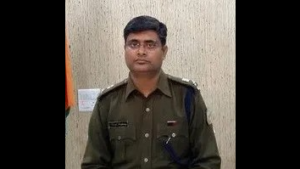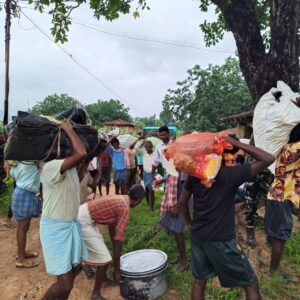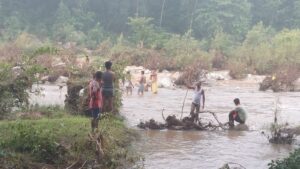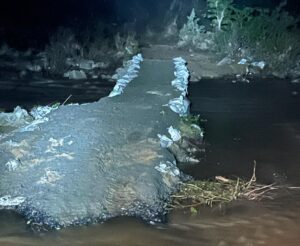M F AHMAD
Daltonganj, Sept 9: The infamous Burha Pahar is back to normalcy. It is disengaged from the Maoists and the ongoing offensive against the CPI Maoists has been stopped. Now the consolidation of the security forces is underway in its place, according to highly well-placed sources in the security set-up.
Deputy Inspector General of Police (Special Task Force) Anoop Birtharay, a 2006-batch Jharkhand cadre IPS officer shared “the relief and jubilation among the commoners living in and around the Burha Pahar which is at peace and free following the emancipation.”

Lagatar24.com correspondent spoke to the DIG (STF) Anoop Birtharay last night around 9.50 pm to know the scene when security forces comprising Jharkhand Jaguar (STF) CoBRA, district police of Latehar and Garhwa regained and retained the Burha Pahar which was under the tyrannic control of the Maoists over nearly two decades.
Q: What was the common man’s reaction to the wresting of the Burha Pahar from Maoists’ clutches?

A: There was an outbreak of hope and freedom. The hope is for a new lease on life. It is freedom from the servitude of the Maoists. Maoists used to treat the common man as their slave or serf. They have forced the common populace to live a sub-human life. The villagers lived here in constant fear and pain of the extremism. It is definitely an Amrit Mahotsav for the people of the Burha Pahar.
Q: Is it true that Pundaag and Pipradhaba villages, situated in the nearest contiguity of the Burha Pahar, have borne Maoists’ cruelties for over a decade?
A: These two villages were at the receiving end of the atrocities and curbs of the Maoists for a long time. They used to visit their houses at night and demand food. The poor households had no option but to succumb to the demands of the Maoists then. There was always a kind of fear in the air here.
Q: Then these people who used to give food and other things to the Maoists would have to face the music from the police for harbouring them. Was this not a dilemma for the locals of these villages?
A: These villagers were caught in a no-win situation. The Maoists used to harass or better say torture them at night. In the day, police used to knock at the doors of the villages for extending help or assistance to Maoists. It was a terrible time here for the villagers. They were in the mesh of life.
Q: Did any villager recount his sandwiching between Maoists and police to you or your men in Jharkhand Jaguar?
A: Many villagers told us how they were pushed behind the bars by the police as these Maoists had rested in their houses perforce and had eaten their own ration meant for the below poverty line people at one point in time or another.
Q: Are there going to be security posts set up here to keep the Maoists at bay?
A: Security posts would be set up here in adequate numbers. It will not be fair right now to give its exact numbers. You will know when it will be there. It will be atop the Burha Pahar and down the foothill. We already have 4 security camps having strategic importance.
Q: Some 10-15 years ago, villagers used to resist security posts’ set up in Palamu. Everybody who mattered in the security management knew it was a proxy battle with the Naxalites behind it. Was there any resistance now?
A: Oh no. Not at all. Amazingly, everyone openly hailed the setting up of the security camps. There was a paradigm shift in the approach to the security camps. It is now seen as a protective shield. I understand the villagers have now learnt that security posts are to augment their economy.

Q: How will their economy be butteressed?
A: The villagers will be selling milk, eggs, vegetables, food grains, spices and other eatables to our jawans and officials here who will be deployed in the security posts. This will add to their income.
Q: Was there a lack of coordination among the different forces engaged in Burha Pahar’s liberation?
A: Our coordination was flawless. It was well-knit and meticulous. The Jharkhand police have a sound track of coordination with the central para-military forces. No problem ever arose.
Q: It is said Jharkhand sector IG of the CRPF Amit Kumar was the moving force behind this operation.
A: Everyone tried to give his best. The Jharkhand sector IG CRPF Amit Kumar is there. He gave his time and attention. The assistance of the CRPF is paramount. So is the important contribution of the district police of Latehar and Garhwa. Our Jharkhand Jaguar did a tremendous job like the other two forces here. The state police headquarters never for a moment took off its eyes from the ongoing operations. It remained with us all the time encouraging us to do what the situation demanded then. From the state police headquarter to the Jharkhand sector IG of the CRPF everyone looked determined and committed to driving away the Maoists entrenched here.
Q: Is it correct that CRPF along with other forces has readied a workable pathway in the rain-fed river Burha Nadi?

A: A pathway in the rain-fed river is workable now. It was a great venture of all the CRPF and us. It will help the boys to reach the logistics of the security camps to be set up there. This pathway is open to the villagers. They are free to use to reach the market for anything they require like medicines, food and other essentials of life. Our pathway will be a big boon to the pregnant woman. Villagers used to negotiate waist-level water in the Burha Nadi for around 2 months every year. Now this pathway will ease them of this stress and strain.








